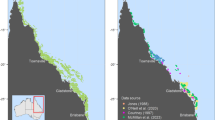Abstract
Research surveys at sea are undertaken yearly to monitor the distribution and abundance of fish stocks. In the survey data, a small number of high fish concentration values are often encountered, which denote hotspots of interest. But statistically, they are responsible for important uncertainty in the estimation. Thus understanding their spatial predictability given their surroundings is expected to reduce such uncertainty. Indicator variograms and cross-variograms allow to understand the spatial relationship between values above a cutoff and the rest of the distribution under that cutoff. Using these tools, a “top” cutoff can be evidenced above which values are spatially uncorrelated with their lower surroundings. Spatially, the geometric set corresponding to the top cutoff corresponds to biological hotspots, inside which high concentrations are contained. The hotspot areas were mapped using a multivariate kriging model, considering indicators in different years as covariates. The case study considered here is the series of acoustic surveys Pelgas performed in the Bay of Biscay to estimate anchovy and other pelagic fish species. The data represent tonnes of fish by square nautical mile along transects regularly spaced. Top cutoffs were estimated in each year. The areas of such anchovy hotspots are then mapped by co-kriging using all information across the time series. The geostatistical tools were adapted for estimating hotspot habitat maps and their variability, which are key information for the spatial management of fish stocks. Tools used here are generic and will apply in many engineering fields where predicting high concentration values spatially is of interest.







Similar content being viewed by others
References
Bartolino V, Maiorano L, Colloca F (2011) A frequency distribution approach to hotspot identification. Popul Ecol 53:351–359
Chilès JP, Delfiner P (2012) Geostatistics: modelling spatial uncertainty, 2nd edn. Wiley, New York, pp 299–385
Desassis N, Renard D (2013) Automatic variogram modeling by iterative least squares: univariate and multivariate cases. Math Geosci 45:453–470
Doray M, Masse J, Petitgas P (2010) Pelagic fish stock assessment by acoustic methods at Ifremer. http://archimer.ifremer.fr/doc/00003/11446/
Lehuta S, Mahevas S, Petitgas P, Pelletier D (2010) Combining sensitivity and uncertainty analysis to evaluate the impact of management measures with ISIS-Fish: marine protected areas for the Bay of Biscay anchovy (Engraulis encrasicolus) fishery. ICES J Mar Sci 67:1063–1075
Matheron G (1982) La déstructuration des hautes teneurs et le krigeage des indicatrices. Note N-761, Centre de Géostatistique, Fontainebleau, France. cg.ensmp.fr/bibliotheque/public/
Myers N, Mittermeier R, Mittermeier C, da Fonseca G, Kent J (2000) Biodiversity hotspots for conservation priorities. Nature 403:853–858
Nelson T, Boots B (2008) Detecting spatial hot spots in landscape ecology. Ecography 31:556–566
Renard D, Bez N, Desassis N, Beucher H, Ors F, Laporte F (2014) RGeostats: the geostatistical package [version 9.1.10]. MINES ParisTech. Free download from: http://cg.ensmp.fr/rgeostats
Rivoirard J (1994) Introduction to disjunctive kriging and non-linear geostatistics. Clarendon Press, Oxford
Rivoirard J, Demange C, Freulon X, Lécureuil A, Bellot N (2013) A top-cut model for deposits with heavy-tailed grade distribution. Math Geosci 45:967–982
Santora J, Sydeman W, Schroeder I, Wells B, Field J (2011) Mesoscale structure and oceanographic determinants of krill hotspots in the California current: implications for trophic transfer and conservation. Prog Oceanogr 91:397–409
Stuart-Smith R, Bates A, Lefchek J, Duffy J et al (2013) Integrating abundance and functional traits reveals new global hotspots. Nature 501:539–542
Yasuda T, Yukami R, Ohshimo S (2014) Fishing ground hotspots reveal long-term variation in chub mackerel Scomber japonicus habitat in the East China Sea. Mar Ecol Prog Ser 501:239–250
Acknowledgments
We are thankful to the crew of R/V Thalassa for operating the vessel during the annual surveys and to P. Duhamel, P. Grellier and M. Rabiller technicians at Ifremer for their work with the biological and acoustic data. We would like to thank the reviewers and the editor for their comments which improved the manuscript.
Author information
Authors and Affiliations
Corresponding author
Rights and permissions
About this article
Cite this article
Petitgas, P., Woillez, M., Doray, M. et al. A Geostatistical Definition of Hotspots for Fish Spatial Distributions. Math Geosci 48, 65–77 (2016). https://doi.org/10.1007/s11004-015-9592-z
Received:
Accepted:
Published:
Issue Date:
DOI: https://doi.org/10.1007/s11004-015-9592-z




